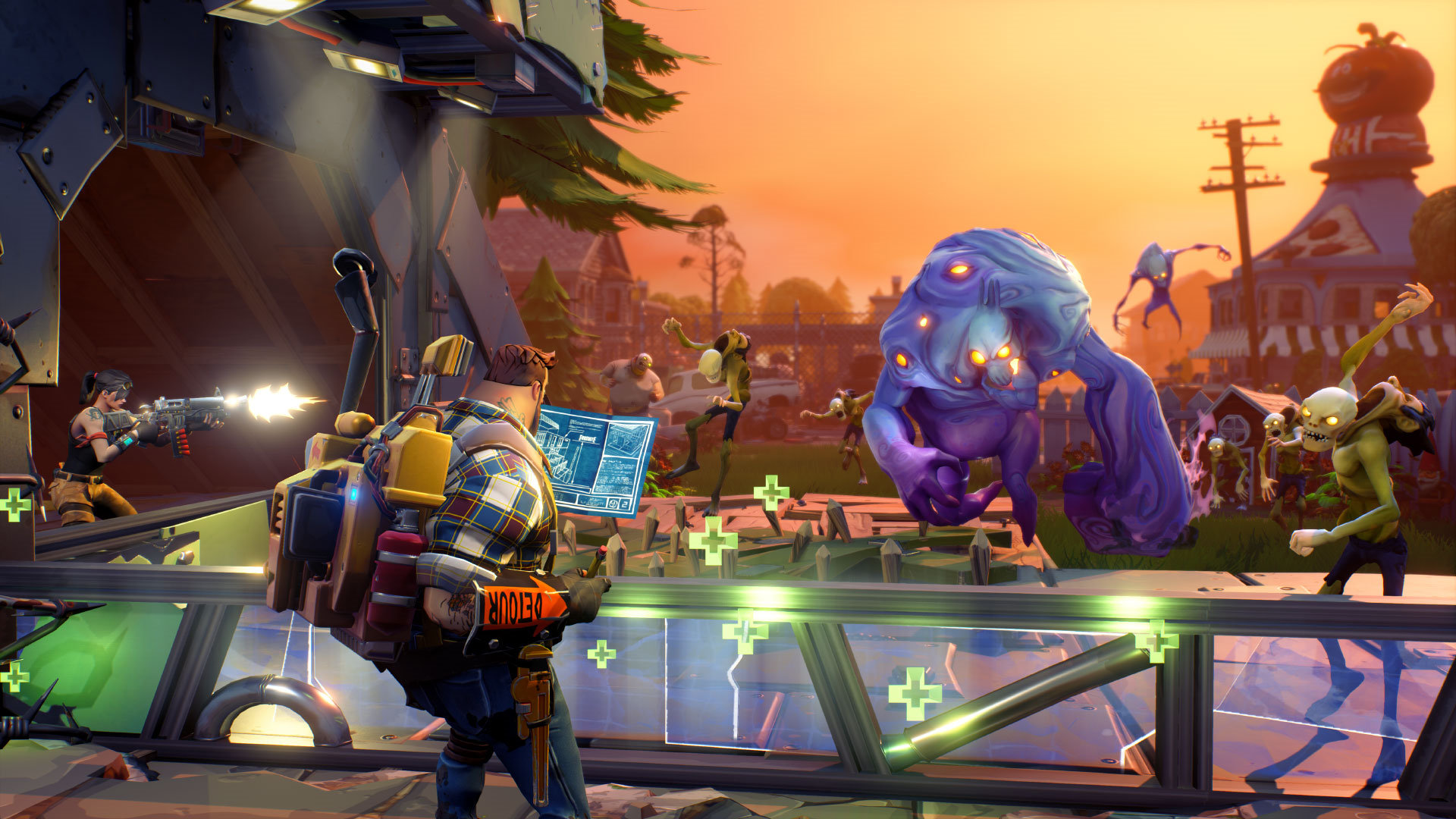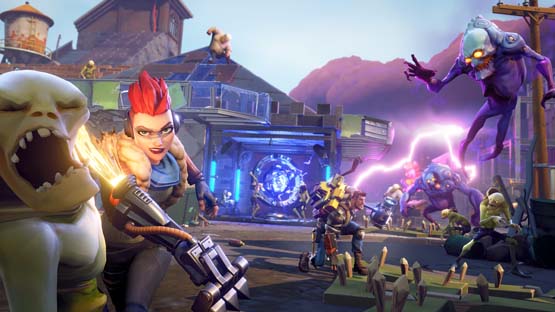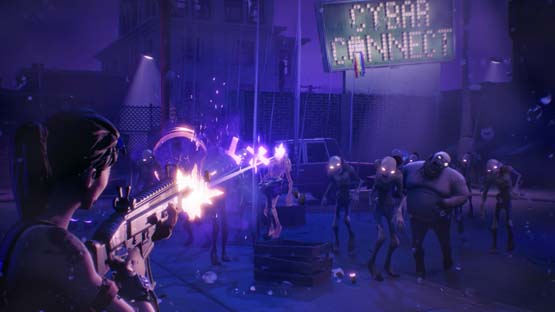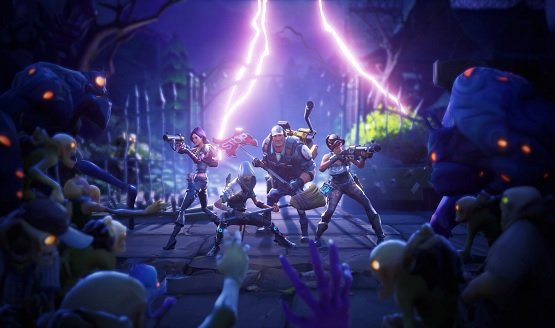Fortnite is an interesting departure from previous Epic Games and People Can Fly projects of the past. Ditching the grisly natures of Gears of War and Bulletstorm, Fortnite instead employs a lighthearted tone akin to the charm and humor of Plants vs. Zombies, the on-the-fly building of Minecraft, and the co-op hero and run n’ gun fun of Borderlands. It might sound unwieldy, but Fortnite actually handles all of these things with impressive gusto. That said, one of the biggest odd things out is this: Fortnite‘s Early Access costs money and Epic has already announced plans to make the game free-to-play in 2018, which begs a question. Is Fortnite worth paying for now?
For the uninitiated, Fortnite takes place in a world ravaged by a malicious and constant storm that spawns ravenous, zombie-like monsters known as husks. Among the survivors, heroes have risen to build settlements, fight the storms, and save survivors left in in the urban wild. Once you finish some tutorials on how to fight, build, and otherwise interact with the world, you’re set on a course of missions to thwart the storms and bring survivors into your collective.
Fortnite’s Standard Edition ($39.99) starts you off with a single hero and a collection of loot crates, which in this game are Loot Piñatas. They contain various content, including heroes, survivors to staff various base functions, and weapon and trap schematics to craft gear. These Loot Piñatas are where a major pay-to-play feature comes into the game. You can score a few of them through game progression or pay real money for a currency that allows you to buy more quickly. You can also score loot through completing missions, but progression is slow enough and the bigger Loot Piñatas are so heavy with extras that it’s clearly where Epic intends to make its money now and later. For now it’s just an extra tab on top of whatever edition you already paid for.

That said, once you get a few heroes and weapons, you already have what you need to get going. Fortnite features four main classes with various hero types in each class, complete with common, rare, and legendary variants that carry different colors and boosted stats. Soldiers make the most of all firearms, ninjas can reach the otherwise unreachable and make best use of swords, outlanders get the most out of loot and treasure hunting, and constructors get building bonuses and handle hammers with extra authority. Each class feels fun and they all play sufficiently different enough to warrant exploring them all.
Where this falters a bit is in the extra heroes. Fortnite totes different hero types in each class. However, while a few of the stats and some of the in-between passive skills vary, every hero in the same class has the same set of activated skills. The only difference is what order they unlock in as you level that hero. The hero pool features different colors and models and the various passives favor certain active skills or attributes, but the difference doesn’t feel very distinct between heroes in the same class pool. It would be more fun if Fortnite’s many heroes featured an activated skill or two that sufficiently set them apart, especially for the harder-to-get ones.
It could be said that a lot of Fortnite’s systems feel cumbersome rather than engaging. There’s various leveling systems in the game which power up everything from hero stats to unlocking new features. Passive teams that supply global benefits can be unlocked and slotted with survivors. Survivors are earned like loot and come in different forms as doctors, recon, and other roles. You can also get active defenders which can be summoned to defend your bases if you arm them. Furthermore you can unlock support slots on your heroes and slot survivors in to further boost their stats. If this sounds overly complicated, it’s because it is.

Fortnite spends too much time with unlocking features. You’ll constantly track down new survivors and sit on them for entire play sessions while you work to unlock a slot they fill. The micromanagement isn’t awful, but the time it takes to open up even the most basic access to various utilities feels annoyingly lengthy. It’s a shame because down the line these bonus roles look to be super helpful. The game could just do with some heavy streamlining in how long it takes to make use of the entry-level options.
Where Fortnite really works for your money is in the mission gameplay. Getting those trap and weapon schematics pays off when you’ve found the tools to make them. In contrast to hero types, weapons mostly feel refreshingly different from one another. Each has different levels rarity, but one assault rifle with a steady damage and standard size clip will do much different things than another that hosts a huge clip and massive fire rate. Testing out all sorts of weapons and finding the ones that fit your style feels great.
Then there’s the building. Fortnite has one of the most free-flowing build mechanics in any action game. Putting together a small fortress with walls, ceilings, floors, doors, and traps is a snap. However, when you start getting into editing, which allows you to punch holes in a grid to make different shapes for each building shape, then you can get superbly creative with your designs. The missions are great for helping you learn too. Once in a while, you’ll come across a tower blueprint that will offer you a bonus if you can finish it. This is Fortnite’s way of teaching you to bend the editing tool to your whims and the prize that comes for activating a built tower is almost always worth it. With a little practice, every player can be taught quickly to build their own personalized fortress and the game rewards that creativity.

Unfortunately, Fortnite’s gameplay suffers is in how it challenges you to utilize these fun tools. Missions come in various forms, including defending an objective or saving survivors. That said, once you’re about six or seven missions in, they start repeating in an area of the game. That means you’re quickly and constantly taking on higher-leveled variants of the same missions as you clear objectives that can apply to any given base scenario.
The husks are slow to change up the challenge as well. Every once in a while, you’ll get a different variant of husk that poses a different threat, but there are only a handful of truly creative and challenging ones. The big brutes are bullet sponges that can bash through your structures and another variant lobs explosives overhead that can damage your defenses if left too long. Outside of that, everything else feels like mixed fodder that does little to change your strategy if you can just build and funnel them properly.
So is Fortnite worth money right now when you might as easily just wait to play later when it’s free? It’s easy to lean into a yes based on the sheer fact that the game is already chockfull of things to do. Furthermore, it certainly has a good start going for it, as evidenced by its recently reported clearing of one million players. That said, Fortnite needs to boost certain areas and pull back on others. The base menu needs major streamlining to get you to the goods and get you back to building and shooting where the game shines. In the active play, missions could use some variance and more unique threats could take the game to a new tier of value on all fronts. Improvements aside, Epic and People Can Fly have built a solid foundation for a game that feels like a good deal more than Early Access. Sure, there’s bumps to smooth out and those that cherish the sweet taste of free will most likely find a much more balanced product in 2018, but Fortnite in 2017 is something that won’t disappoint you if you invest in it.
For even more on Epic Games’ latest, check out our Fortnite early access impressions.








